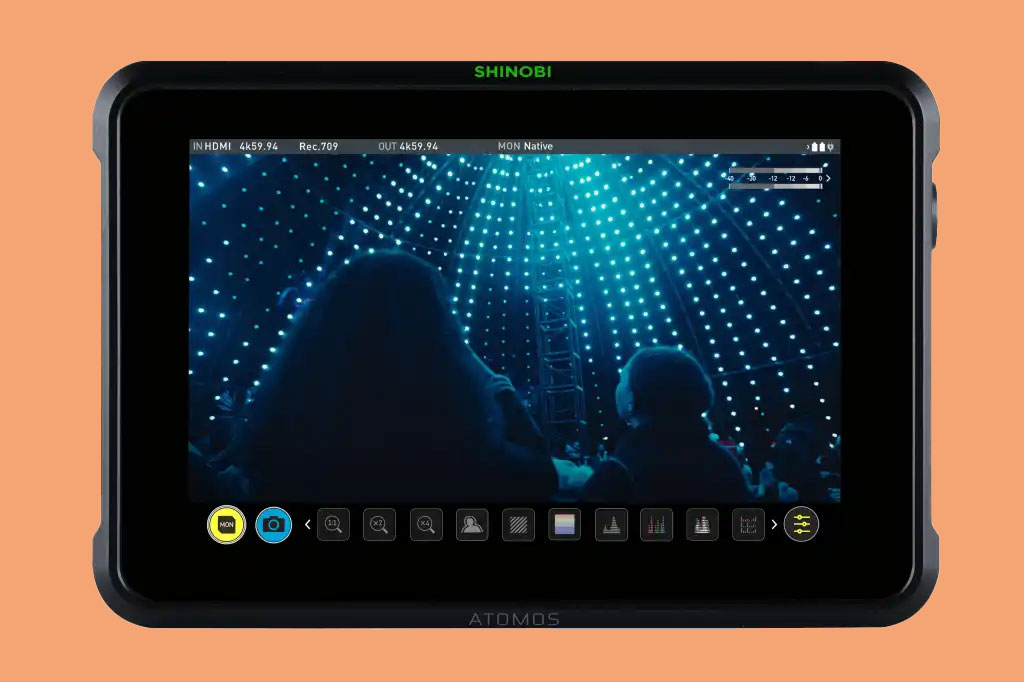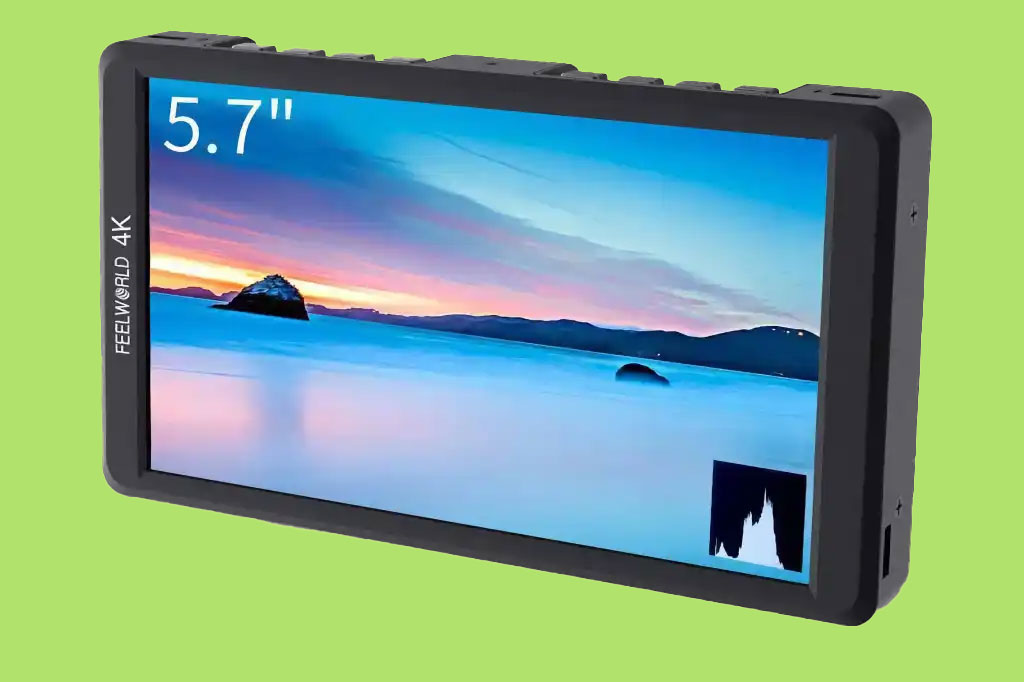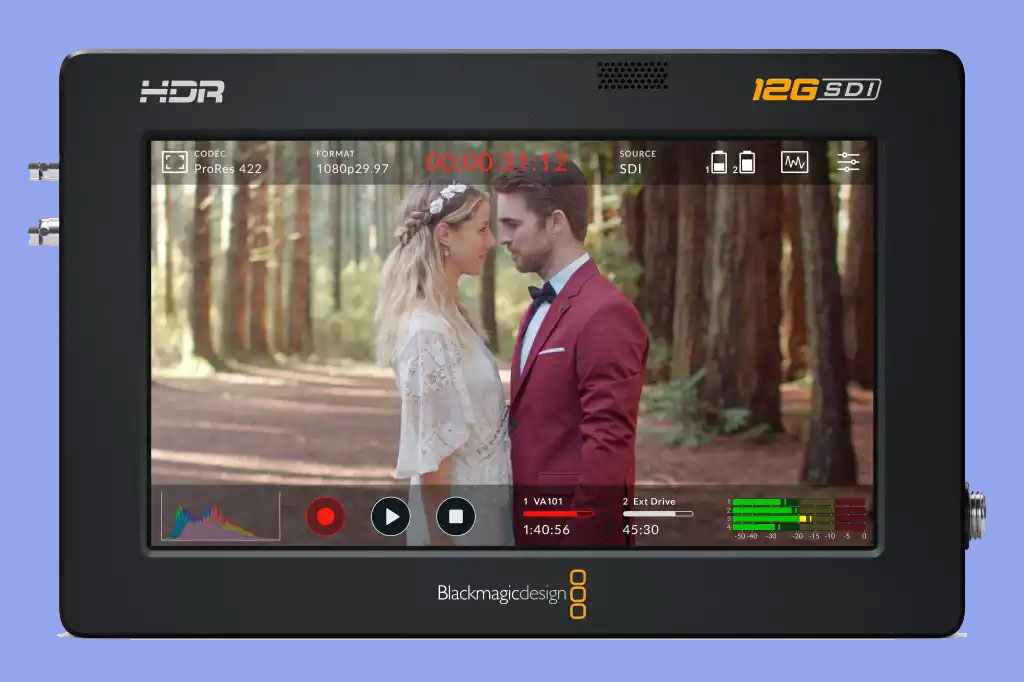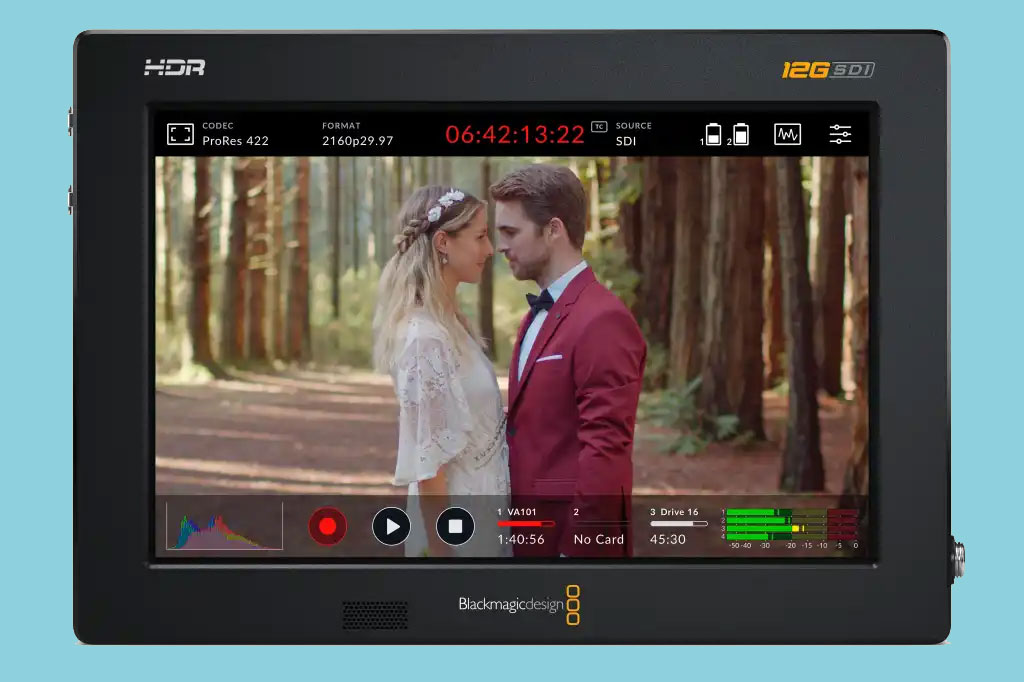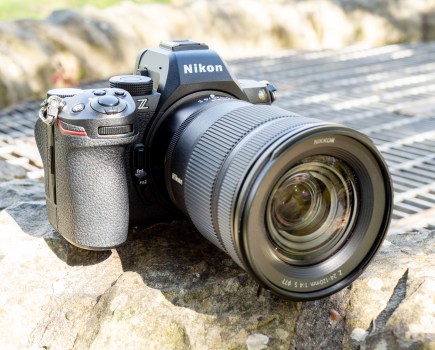In this guide, we test the best external camera screens, monitors and recorders — the videography accessories you may not have known you needed in your camera bag. A must for any serious video rig, a dedicated monitor solves several problems at a stroke, and can potentially expand your video options far beyond your camera’s inherent abilities.
Even the absolute best mirrorless cameras, best DSLRs and best video cameras have built-in screens that are generally too small to see from any kind of distance. LCD screens are generally around 3 inches, sometimes a little more on high-end cameras, which also makes it hard to display critical shooting settings clearly. They are also generally easily swamped by outdoor glare, and in some cases can’t be angled easily in all directions.
With an external monitor, these problems go away. And what’s more, if you pick a monitor with recording capability, you’ll also potentially be able to record video at higher resolutions and frame rates than the camera otherwise could. Here is our roundup of recommendations: what each one does and how it works. Products are grouped into families and brands to make it easier to compare the features of these camera monitors. We’ve also picked monitors with and without recording capabilities, for a broader range of choice.
Best external camera screens: Quick list
Looking for the best deal on best external camera screens, monitors and recorders? Not only will you find the best of them, but also some of the best external camera screens, monitors and recorder deals, as our ‘Buy now’ buttons are setup to automatically take you to the best prices from trusted retailers. You’ll also find a list of other retailers below each screen, so you can find the right deal for you.
- Best external video recorder overall: Atomos Ninja V – Buy now
- Best professional video recorder: Atomos Ninja V+ – Buy now
- Best simple video monitor: Atomos Shinobi II – Buy now
- Best large monitor for video: Atomos Shinobi 7-inch – Buy now
- Best cheap video monitor: Feelworld F570 5.7-inch – Buy now
- Best video monitor for 3D LUTs: Feelworld LUT7 – Buy now
- Best Full HD video monitor: Blackmagic Design Video Assist 5 inch 3G – Buy now
- Best video monitor for outdoor shooting: Blackmagic Design Video Assist 5-inch 12G HDR – Buy now
- Best home studio video monitor: Blackmagic Design Video Assist 7-inch 3G – Buy now
- Best money-no-object video recorder: Blackmagic Design Video Assist 7-inch 12G HDR – Buy now
Read on to learn more about each of these external screens, and for more tips, check out our guide to the best accessories for video you can get for your setup, as well as the best value audio accessories.
Why you can trust Amateur Photographer
We spend many hours testing every product we recommend, in detail, in a variety of situations and shooting scenarios, and only use experts for our reviews, so you can be sure that you’re getting the best products. Find out more about our expert writers.
BEST RECORDER OVERALL
Best external video recorder overall: Atomos Ninja V
Amateur Photographer verdict
The best external screen and recorder for most purposes, the Atomos Ninja V is an institution in the video world.- Can capture 4K Pro Res Raw video
- Great value for money
- SSD storage not included
- Screen: 5-inch touchscreen, 1920 x 1080, 1000 cd/m²
- Max video resolution/frame rate: 4K 60, FHD120, ProRes Raw
- Storage: SSDmini/SSD with Master Caddy II/III
- Weight: 360g
- Website: www.atomos.com
The Atomos Ninja V is the best external camera screen and recorder to buy today. It’s been around for a while and has become practically the standard external monitor for many mirrorless cameras – its ability to capture 4K ProRes Raw video has seen it adopted by many camera makers. It’s also opened up the potential for raw capture with cameras that don’t support it internally; though some models may require a firmware update.
Given its capabilities, the Ninja V is great value, and many videographers will need look no further. SSD storage is not included, however, and Atomos’s own storage media is expensive – though there are cheaper third-party solutions.
BEST PRO VIDEO RECORDER
Best professional video recorder: Atomos Ninja V+
Amateur Photographer verdict
For shooting at ultra-high resolutions, the Ninja V+ is a high-end monitor and recorder. It also boasts a slightly larger screen than the original Ninja V.- Can handle 8K footage
- Good screen size
- Manages 4K at up to 120fps
- More expensive than Ninja V
- Screen: 5.2-inch touchscreen, 1920 x 1080, 1000 cd/m²
- Max video resolution/frame rate: 8K 30, 4K 120
- Storage: SSDmini/SSD with Master Caddy II/III
- Weight: 360g
- Website: www.atomos.com
The standard Atomos Ninja V tops out at a resolution of 4K 60, which is sufficient for most filmmakers. However, as so many cameras now shoot 6K or 8K, the Ninja V+ has been made to handle these much higher resolutions; offering 8K capture at 30fps and 4K at an impressive 120fps.
The screen is slightly larger than the Ninja V’s at 5.2 inches, though the difference is barely noticeable. The resolution and maximum brightness are the same – as is the interface, storage and even the weight. The Ninja V+ is more expensive than the original, as you’d expect, but not a whole lot more when you take into account its 8K capture capabilities.
BEST SIMPLE VIDEO MONITOR
Best simple video monitor: Atomos Shinobi II
Amateur Photographer verdict
An excellent 5in monitor thats inexpensive and brighter than most monitors on the market. The new camera control feature is a welcome addition however it needs fine tuning.- Very bright display
- Great monitoring display features
- Lightweight and slim design
- Good to have USB power in and out
- Camera Control not as good as it could be
- Takes a long time to power up
- Screen: 5.2 inch touchscreen, 1920 x 1080, 1500 cd/m²
- Max video resolution/frame rate: 4K 30, FHD 60
- Weight: 210g
- Website: www.atomos.com
Not everyone needs an external recorder. Many current cameras offer internal recording at 10-bit quality, perfectly good enough for log recording and colour grading later. An external monitor is still a worthy shooting accessory, however; its improved display is probably worth at least as much as, if not more than, external recording features.
So if you just want the Ninja V’s 5-inch display but not its internal recording, then the Shinobi II is ideal. It’s a lot cheaper than the Ninja V and barely two-thirds the weight – and weight is a big factor if you’re going to mount your external monitor on the camera. Be aware, though, that the resolution tops out at 4K 30p or FHD at 60p; many of the best mirrorless cameras can go beyond this.
The Shinobi II is the third external screen in the Shinobi line-up, it upgrades the previous Shinobi 5 with built in camera control, and features the new Multiscope Analysis View that shows lots of recording information on the go. There is also Atomos and Arri False Color, and EL Zone System that shows coloured zones marked in stops to help you get the subject exposed to 18% grey.
Read our full review of the Atomos Shinobi II
BEST LARGE MONITOR
Best large monitor for video: Atomos Shinobi 7 (7-inch)
Amateur Photographer verdict
This generously sized monitor delivers a brilliant picture with excellent brightness – though it comes at a cost, and it’s a heavy thing to have mounted on a camera, particularly if shooting handheld.- Big, beautiful display
- Bright 2200nit screen
- Lots of useful videography features
- Gets heavy with batteries
- Battery drains quickly
- Screen: 7-inch touchscreen, 1920 x 1200, 2200 nits
- Max video resolution/frame rate: 4K 60
- Storage: N/A
- Weight: 577g
- Website: www.atomos.com
You may have grokked by now that the Atomos external monitor range has two main families: the Ninjas offer external recording too, while the Shinobis are just for monitoring. The Shinobi 7-inch, as the name suggests, boasts a larger screen than the Ninja Models or the smaller Shinobi 5-inch. It can also display 4K 60 video and has a higher maximum brightness than the Shinobi 5-inch.
However, it is twice the price and more than twice the weight, so you’d probably keep this for higher-end setups where you need the bigger screen and are using a setup where the weight matters less – 577g would be a lot to have fixed to the top of the camera if you’re shooting handheld or with a gimbal.
Read our full review for the Atomos Shinobi 7 here.
BEST CHEAP VIDEO MONITOR
Best cheap video monitor: Feelworld F570 5.7-inch
Amateur Photographer verdict
Cheaper than its rivals, the Feelworld monitor is lightweight and easy to use – though brightness can be an issue.- Excellent value
- Light enough to sit on hotshoe
- Resolution maxes at 4K 30p
- Not the brightest screen
- Screen: 5.7-inch touchscreen, 1920 x 1080, 460 cd/m²
- Max video resolution/frame rate: 4K 30, FHD 60
- Storage: N/A
- Weight: 200g
- Website: https://feelworld.ltd
Atomos and Blackmagic are the big names in external camera screens, and not small in price. For a more affordable monitor without external recording, there are other brands; Feelworld being one of the most widely available.
This 5.7-inch display costs a good deal less than Atomos and Blackmagic equivalents, and its 200g weight means it can sit quite nicely on a DSLR or mirrorless camera hotshoe without overbalancing your setup. It can display 4K 30p footage or Full HD at 60p, which will be enough more many filmmakers, though its screen is not the brightest, which could affect its usability outdoors.
For another budget option, have a look at the Feelworld F6 Plus 5.5in field monitor.
BEST FOR 3D LUTs
Best video monitor for 3D LUTs: Feelworld LUT7
Amateur Photographer verdict
Another good-value offering from Feelworld, this 7-inch monitor may be heavy, but it’s affordable, and it can preview custom 3D LUTs.- Good price for a 7-inch screen
- Advanced preview options
- Heavy
- No resolution bump on 5.7-inch model
- Screen: 7-inch touchscreen, 1920 x 1080, 2200 cd/m²
- Max video resolution/frame rate: 4K 30, FHD 60
- Storage: N/A
- Weight: 460g
- Website: https://feelworld.ltd
The Feelworld LUT7 offers a 7-inch display for less than the price of 5-inch external monitors from Atomos or Blackmagic. It’s another monitor-only device (no external recording) but that is often enough in itself. It shares the same maximum 4K 30 frame rate as the smaller 5.7-inch model, yet does have the ability to preview custom 3D LUTs, which can be important when working with colourists or on more advanced film projects.
While the price is very good for a 7-inch external display, it’s worth pointing out that the larger screen size practically doubles the weight; which may be less practical for handheld or gimbal shooting. This is a factor with all 7-inch external screens. It’s also worth spending some time checking out the full Feelworld external monitor range, as it is pretty extensive.
BEST FULLHD VIDEO MONITOR
Best Full HD video monitor: Blackmagic Design Video Assist 5-inch 3G
Amateur Photographer verdict
This baby recorder from Blackmagic is a bit of a curio, and will suit quite a specific user – namely one not interested in 4K.- Slots well into Blackmagic ecosystem
- Can record straight to UHS-II SD
- Lacking brightness
- Tops out at Full HD 60p
- Does not support Blackmagic Raw
- Screen: 5-inch touchscreen, 1920 x 1080, 300 cd/m²
- Max video resolution/frame rate: FHD 60
- Storage: SD UHS-II
- Weight: 410g
- Website: www.blackmagicdesign.com
Blackmagic Design is another big name in external screens alongside Atomos. Its four combined external monitors/recorders are designed to dovetail with Blackmagic’s full system of cinema cameras, switchers and other video production tools – but they work well with other-brand cameras too – with some factors taken into account.
The Blackmagic Video Assist 5-inch 3G is the baby of the range, though is no cheaper than a Ninja V and is restricted to FHD 60 video capture. It really only makes sense if you’re using a 1080 video workflow rather than 4K. Another disadvantage is that it’s one of the least bright screens out there, so might need some shading in bright outdoor light.
On the upside, it can record video straight to UHS II SD cards rather than the more expensive SSD storage used by Atomos. On the downside, it does not support the Blackmagic raw format, though it can capture video in high-quality Apple ProRes.
BEST FOR OUTDOOR SHOOTING
Best video monitor for outdoor shooting: Blackmagic Design Video Assist 5-inch 12G HDR
Amateur Photographer verdict
With super-fast interface speeds and an ultra-bright screen, this powerful recorder is suited to professional users.- Fast 12G-SDI interface
- Excellent screen brightness
- Records to USB-C SSD
- Relatively expensive
- Screen: 5-inch touchscreen, 1920 x 1080, 2500 cd/m²
- Max video resolution/frame rate: 4K 60
- Storage: SD UHS-II, USB-C SSD
- Weight: 410g
- Website: www.blackmagicdesign.com
This is a much more powerful alternative to the basic VideoAssist 5-inch 3G model. The ’12G’ comes from its faster 12G-SDI interface – SDI is a common digital interface in the video industry with higher-end gear and, like HDMI, comes in different speeds. The Video Assist 5-inch 12G also has a faster HDMI 2.0 interface than the older HDMI 1.4 port on the 3G model. Between them, these faster connections allow 4K 60 capture.
That’s by no means the only advantage of the 12G model. It has a screen six times brighter, which makes a big difference for outdoor shooting, plus the ability to record straight to a USB-C SSD as an alternative to an SD card.
The Video Assist 5-inch 12G can also record Blackmagic raw video; provided that the camera is compatible. Blackmagic’s own cinema cameras are, of course, as are a number cine and filmmaking cameras from other brands, though at the DSLR/mirrorless end of the market, support for this format is not yet as wide as that for the Atomos Ninja V and its Apple ProRes.
BEST HOME STUDIO MONITOR
Best home studio video monitor: Blackmagic Design Video Assist 7-inch 3G
Amateur Photographer verdict
While there are definitely cheaper alternatives at this screen size, Blackmagic’s Video Assist 7-inch 3G offers external ProRes recording.- Nice big display
- External ProRes recording
- Screen isn’t the brightest
- Quite heavy
- Screen: 7-inch touchscreen, 1920 x 1080, 310 cd/m²
- Max video resolution/frame rate: FHD 60
- Storage: SD UHS II
- Weight: 825g
- Website: www.blackmagicdesign.com
If you’re happy sticking with a Full HD video workflow and just need a larger screen, then the Video Assist 7-inch 3G is the logical upgrade from the 5-inch 3G version. However, as well as sharing the same resolution limit, it also has a much dimmer screen than Blackmagic’s newer 12G models. Not only that, with a weight of 825g, it’s not well suited to handheld or gimbal use, and will be more at home attached to a proper cinema rig.
If you just need a bigger monitor, there are cheaper alternatives, though the Video Assist 7-inch 3G’s external ProRes recording could be an advantage. As the whole industry shifts towards 4K as a baseline standard these days, Blackmagic’s 12G external screens look a much better buy.
BEST FLAGSHIP RECORDER
Best money-no-object video recorder: Blackmagic Design Video Assist 7-inch 12G HDR
Amateur Photographer verdict
A superb professional monitor and recorder, this is the most expensive option, but more than justifies its price, especially if you’re shooting on Blackmagic gear.- Big screen
- Professional features
- Expensive
- Screen: 7-inch touchscreen, 1920 x 1080, 2500 cd/m²
- Max video resolution/frame rate: 4K 60
- Storage: 2x SD, USB-C SSD
- Weight: 825g
- Website: www.blackmagicdesign.com
The Video Assist 7-inch 12G HDR is top dog in Blackmagic’s Video Assist range, and the next step up from here is full-scale professional monitoring equipment, which is a whole new ballpark. It’s more expensive than the Atomos Ninja V at the top of our list, but it does have a bigger 7-inch screen.
The nearest equivalent from the Atomos range is the Shogun Connect 7, which is like a 7-inch version of the 8K Ninja V+ but with wireless connectivity too for production teams and remote collaboration – so probably a step beyond the scope of most solo shooters and vloggers.
The Video Assist 7-inch 12G HDR would make a lot of sense in professional filming situations especially those involving other Blackmagic gear and DaVinci Resolve (one of the best video editors). For single users though, the Atomos Ninja V might prove the most cost effective, widely compatible and practical solution all round.
Other options for external camera screens
Some film makers and video creators use the Sigma fp camera as an external viewfinder, as it can simulate LUTs and CINE framing options needed by high-end film makers. Another option is to use a Sony Xperia 1 IV or Xperia 1 V, which can be used as high-res external screens.
What to look for in the best external camera screens
- Screen size: external monitors typically have a 5-inch screen, with more expensive 7-inch variants available. These aren’t necessarily better as the larger screen adds to the weight and can upset the balance of your camera rig.
- Screen resolution: this is almost always 1920 x 1080 in the same 16:9 aspect ratio as Full HD or 4K UHD.
- Display brightness: this is quoted in ‘nits’ or 460 cd/m². The higher the value, the easier the screen will be to see in bright daylight. 1000 cd/m² is a good starting point, but 200 cd/m² is better.
- Resolution and frame rates: even the best external camera screens have limits, so make sure you get one that can handle. the video setting you use, e.g. 4K UHD at 30fps. Some cheaper screens are Full HD only.
- External recording/storage: some external monitors can record video at higher resolutions, frame rates or quality levels than the camera. Check the maximum speed and frame rate supported and the type/cost of storage media – storage won’t be included.
Why add another camera monitor?
External camera screens solve problems – sometimes ones you didn’t know you had, or could be fixed.
Typically, they attach to your camera’s accessory shoe via a ball and socket adaptor that lets you angle them in any direction, including forwards for when you need to film yourself. They can also attach to ‘rigs’ or camera ‘cages’ in more advanced setups.
Screen sizes start at around 5 inches, already much larger than the screens on the back of cameras, and with a 1920 x 1080 Full HD resolution that lets you see the finest details.
Different models can also display vectorscopes, waveforms, zebra patterns and other shooting aids, and may be able to simulate LUTs and HDR capture for those using more advanced shooting and editing workflows.
The top camera monitors can transform your video shooting experience just by virtue of their bigger, better displays, and some models offer internal recording, too. This means you can often bypass the file format and codec limitations of your camera’s in-built capture, so that many consumer-grade mirrorless cameras, for example, can capture raw video on an external recorder when that’s not possible internally.
How we test external camera screens
We test external screens, recorders and monitors by taking them on real-world shoots to assess their capabilities. Our video experts will hook them up to an appropriate rig, looking at how easy they are to set up and what kind of mounting options they offer. We evaluate the brightness and clarity of the screens themselves, testing them outdoors to ensure they are useable in sunlight.
We look at how the screen performs in relation to the manufacturer’s claims, examining whether it lives up to what the blurb on the box promises. We look at the number of ports the screen provides, test out the different recording modes if this is something it offers, and assess its battery life on a typical day’s shoot.
Related reading:
- Best cameras for video, vlogging, and videography
- The best lenses for video
- New beginning: How stills photographers are shooting video
- Best video editing software, including free tools
- How to record high quality video with your camera





